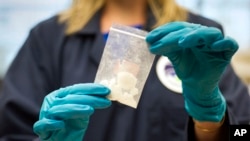Fentanyl is a synthetic opioid drug that mimics the effects of heroin, and indeed, is added to that illicit drug to increase its potency. It is relatively easy to make and even easier to smuggle: due to its high potency, which is 50 times great than heroin and 100 times greater than morphine, a package the size of a sugar pack may contain as many as a hundred doses of fentanyl. And it is deadly. An amount the size of three grains of sugar is lethal to an adult. In the United States, nearly 20,000 overdose deaths in 2015 involved heroin or synthetic opioids such as fentanyl.
Fentanyl, a restricted medication due to its high potential for abuse, has been widely used for legitimate purposes since 1960, first as a general anesthetic during surgery, and today as a painkiller to treat severe pain. But it has also become popular as a recreational drug. Much of the supply for this market is produced illicitly. And because accurately dosing this opioid is very difficult, the incidence of fatal overdoses is high.
Fentanyl is internationally controlled under the Single Convention on Narcotics Drugs. But by changing just one molecule in the formula, an illicit manufacturer creates what’s known as an analogue of fentanyl, a version of the drug that has the same effects but is legal only because it isn’t the exact same chemical composition as Fentanyl itself.
To counter this practice, the United Nations on March 16th added the two main chemicals necessary for the manufacture of Fentanyl, to its international list of controlled substances. With this decision, illicit producers of Fentanyl and fentanyl analogues will lose the easy access to the essential precursor chemicals used to produce fentanyl and fentanyl analogues.
“Adding these precursor chemicals to the 1988 Convention will make it more difficult for traffickers to access them for illicit purposes, because they will now be subject to increased regulation by UN Member States,” said Director of the Office of Policy, Planning and Coordination for International Narcotics and Law Enforcement Affairs, Kara MacDonald.
“I want to express the gratitude of my government for this show of solidarity and support in voting to internationally control precursor chemicals to fentanyl. Let there be no mistake – this vote today will save lives.”












